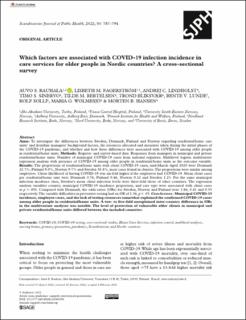| dc.contributor.author | Rauhala, Auvo S. | |
| dc.contributor.author | Fagerström, Lisbeth | |
| dc.contributor.author | Lindholst, Andrej C. | |
| dc.contributor.author | Sinervo, Timo S. | |
| dc.contributor.author | Bertelsen, Tilde M. | |
| dc.contributor.author | Bliksvær, Trond | |
| dc.contributor.author | Lunde, Bente Vibecke | |
| dc.contributor.author | Solli, Rolf | |
| dc.contributor.author | Wolmesjö, Maria G. | |
| dc.contributor.author | Hansen, Morten B. | |
| dc.date.accessioned | 2022-09-08T07:44:52Z | |
| dc.date.available | 2022-09-08T07:44:52Z | |
| dc.date.created | 2022-08-25T12:14:17Z | |
| dc.date.issued | 2022 | |
| dc.identifier.citation | Rauhala, A. S., Fagerström, L. M., Lindholst, A. C., Sinervo, T. S., Bertelsen, T. M., Bliksvær, T., Lunde, B. V., Solli, R., Wolmesjö, M. G. & Hansen, M. B. (2022). Which factors are associated with COVID-19 infection incidence in care services for older people in Nordic countries? A cross-sectional survey. Scandinavian Journal of Public Health, 50(6), 787-794. | en_US |
| dc.identifier.issn | 1403-4948 | |
| dc.identifier.uri | https://hdl.handle.net/11250/3016475 | |
| dc.description.abstract | Aims: To investigate the differences between Sweden, Denmark, Finland and Norway regarding residential/home care units’ and frontline managers’ background factors, the resources allocated and measures taken during the initial phases of the COVID-19 pandemic, and whether and how these differences were associated with COVID-19 among older people in residential/home units.
Methods: Register- and survey-based data. Responses from managers in municipal and private residential/home units. Number of municipal COVID-19 cases from national registries. Multilevel logistic multivariate regression analysis with presence of COVID-19 among older people in residential/home units as the outcome variable.
Results: The proportions of residential/home units with client COVID-19 cases, mid-March–April 2020 were Denmark 22.7%, Finland 9.0%, Norway 9.7% and Sweden 38.8%, most cases found in clusters. The proportions were similar among employees. Client likelihood of having COVID-19 was six-fold higher if the employees had COVID-19. Mean client cases per residential/home unit were Denmark 0.78, Finland 0.46, Norway 0.22 and Sweden 1.23. For the same municipal infection incidence class, Sweden’s mean client infection levels were three-fold those of other countries. The regression analysis variables country, municipal COVID-19 incidence proportion, and care type were associated with client cases at p ⩽ .001. Compared with Denmark, the odds ratios (ORs) for Sweden, Norway and Finland were 1.86, 0.41 and 0.35 respectively. The variable difficulties in preventive testing had an OR of 1.56, p ⩽ .05.
Conclusions: Municipal COVID-19 incidence, employee cases, and the lack of testing resources somewhat explained the confirmed COVID-19 cases among older people in residential/home units. A two- to five-fold unexplained inter-country difference in ORs in the multivariate analyses was notable. The level of protection of vulnerable older clients in municipal and private residential/home units differed between the included countries. | en_US |
| dc.language.iso | eng | en_US |
| dc.rights | Navngivelse 4.0 Internasjonal | * |
| dc.rights.uri | http://creativecommons.org/licenses/by/4.0/deed.no | * |
| dc.title | Which factors are associated with COVID-19 infection incidence in care services for older people in Nordic countries? A cross-sectional survey | en_US |
| dc.type | Peer reviewed | en_US |
| dc.type | Journal article | en_US |
| dc.description.version | publishedVersion | en_US |
| dc.rights.holder | © Author(s) 2022. | en_US |
| dc.source.pagenumber | 787-794 | en_US |
| dc.source.volume | 50 | en_US |
| dc.source.journal | Scandinavian Journal of Public Health | en_US |
| dc.source.issue | 6 | en_US |
| dc.identifier.doi | https://doi.org/10.1177%2F14034948221085398 | |
| dc.identifier.cristin | 2045982 | |
| cristin.ispublished | true | |
| cristin.fulltext | original | |
| cristin.qualitycode | 1 | |

